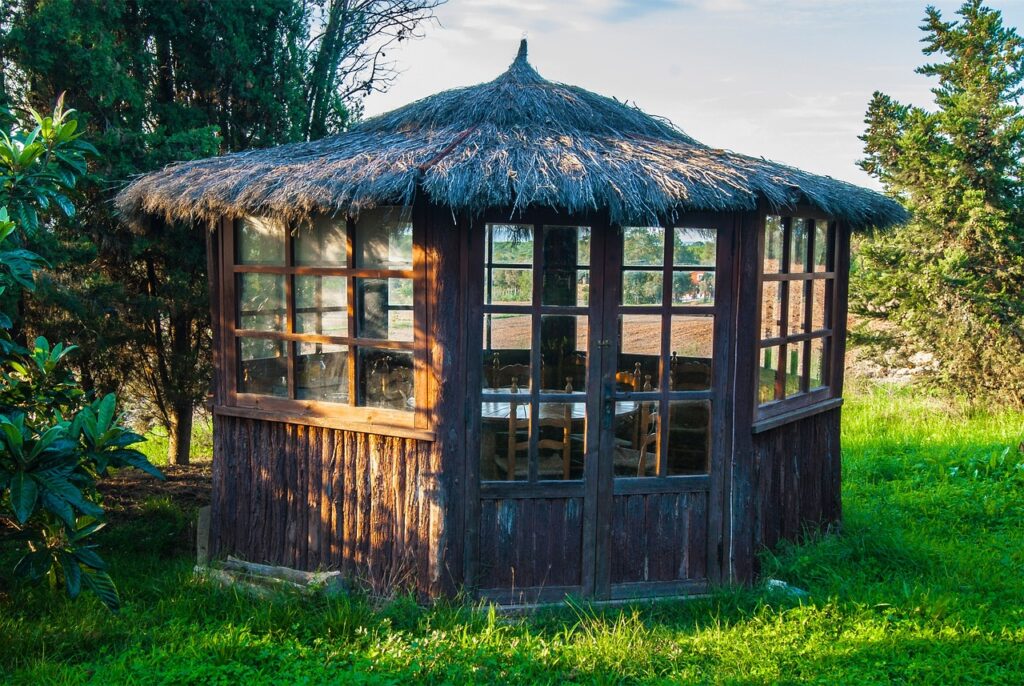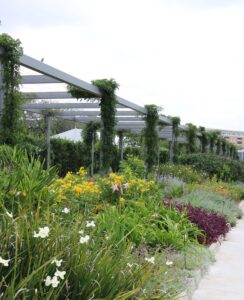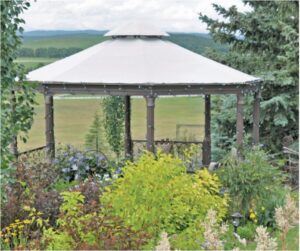A Shelter from the Sun: Gazebos & pergolas
A cool haven from the sun, a temporary protection from the rain, a screened in escape from mosquitoes: arbours, gazebos and pergolas offer us an often romantic outdoor room. Find your dream gazebo.
Pergolas
Pergolas go back over 3,000 years. There is even a surviving garden plan dating back to 1,400 BC showing a pergola as the entry way to a garden belonging to a high Egyptian official in Thebes. Pergolas are frequently designed as walkways and sometimes used to transition from one space to another.
Many pergolas are covered only by vines and may be open on all sides. They can serve as lovely hanging gardens (imagine a pergola filled with baskets of ever bearing strawberries or dripping with grapes). In ancient times, the pillars were made of stone or even marble, topped with vines or by wooden structures that span the two sides or may be latticed for vines to climb on.
In early gardens, pergolas or arbours were sometimes made by simply inter-twining branches to form a protected passage way.
Today, they are made from just about anything, from wood to metal to plastics.Look for nice pergolas.
You can have a very elaborate one built by a contractor or order the components from one of the box stores and do it yourself.
Gazebos
Gazebos are a bit more of a construction than a pergola, but there are still kits that allow you to do the construction yourself – or that a contractor can set up for you if you are backwards with a hammer and nails.
Gazebos have been traditionally designed in a variety of geometrical shapes, hexagonal being one of the favourites, although they can be round, square, rectangular or even octagonal. They have roofs. Other than that, there are no rules. Some have screened in sides, others are open.
Like pergolas, Gazebos go back to at least Egyptian times where they were situated in gardens featuring cooling water brought in by underground aqueducts. The Greeks made their gazebos from marble and dedicated them to the gods. They were placed in gardens or near temples where they were available for public use. The Romans had private gardens featuring gazebos where one could escape the sometimes bloody stresses of Roman life. Check out fancy gazebos here.
In Asia, pagodas, a type of gazebo, were made in lacquered wood by the Chinese. They were used for meditation, while in Japan gazebo-like structures were often used for tea ceremonies.
This kind of outdoor room was common in European gardens starting in the Middle Ages. Sometimes gazebos served as follies in English gardens. Follies were buildings or contrived ruins that provided destination points in the elaborate gardens of the wealthy.
Materials for your gazebo
Put in the strongest base you can afford. A concrete pad or even concrete blocks will add permanence to the structure and help keep the floor from decaying too quickly. The base also ensures stability of the structure.
Cedar heartwood is the most obvious and desired material for today’s gazebos. It has a long lifespan, being insect and mould resistant, and it looks good in the garden. Treated pine has many of the same qualities as cedar. Bamboo is a long-lasting material that would work well in a Zen garden setting.
Plastic or vinyl are options; they are both maintenance-free and don’t need to be painted. Vinyl is more durable than plastic.
Wrought iron is another option for your gazebo. Usually wrought iron gazebos are open and hung with plants, but they may have glass or plastic roofs. Nor is there anything to stop you from having your gazebo made from local stone or brick – it’s your dream and you will want it to fit into your neighbourhood and complement your home.
Today, canvas gazebos are widely available and often feature screens that can be pulled back like curtains. Some are swathed in flowy materials, lending the room a romantic air. Canvas gazebos will have to be dismantled for the winter.
A metal roof will provide the longest life span for your structure, but it is expensive. You could use plastic or even glass. Wood and roofing tiles are another option. Think about your climate before making the final decision. Some of us may even be tempted to close in the sides as a further insurance against weather.
Finally, think about trim. These final touches can make the most impressive statement of all.
(by Jack Farley, The Source: ABG 13S)
















